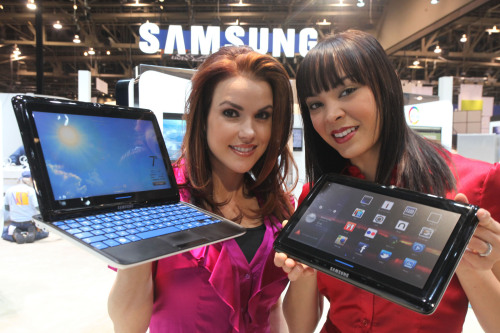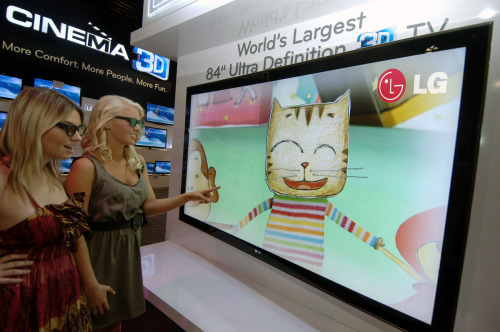CES dominated by new models of 3-D televisions, tablet PCs and upgraded smartphones
LAS VEGAS ― The world’s largest technology tradeshow bore witness to several major technology trends that can be summed up as: 3-D vision and “smart” devices.
Top electronics firms showcased upgraded 3-D televisions that promised to become more comfortable living room features by becoming bigger, yet thinner, and more attractive in design.
LG Electronics wowed the attendees with a mammoth 84-inch 3-D LED TV, while Samsung Electronics showcased a smaller 75-inch model.
Such as was the push for 3-D that Sony chairman Howard Stringer predicted, “In 2011, 3-D becomes personal.” Sony has so far produced everything in the 3-D chain from movies to TVs.
The presence of 3-D TVs appeared to be even greater than that of smart TVs.
Samsung Electronics’ head of visual display Yoon Boo-keun interpreted the 3-D competition as proving that “3-D is now a new way of life.”

Samsung Electronics showcased its Sliding PC 7 series, a combination of a tablet and a laptop, at the Consumer Electronics Show in Las Vegas.(Samsung Electronics)
Forecasts on the 3-D TV market are still quite varied, but Display Search recently said it expects the industry to grow to 91 million units by 2014, up from the 3.2 million forecast for this year.
The 3-D range also stirred debate about 3-D eyewear, as firms are aware that some find their glasses clunky and expensive.
Defying the criticism, Samsung and LG ― the booths that drew the second-largest crowd of attendees at the show ― both showcased savvy new eyewear to make 3-D vision a more comfortable experience.
LG’s glasses received particular attention for their new technology involving the Film Patterned Retarder, which drastically reduces side-effects of existing 3-D glasses, such as flickering and crosstalk.
Japan’s Toshiba went a step further, saying it would be commercializing autostereoscopic technology ― 3-D without eyewear ― by the end of this year, despite mounting doubts over how commercially lucrative the technology will be.
“3-D without eyewear is still a long way from development or becoming affordable,” said LG Display CEO Kwon Young-soo at a press conference on the sidelines of the tradeshow.
But there also is lingering doubt in the market about how well consumers would embrace 3-D.
“The consumers have yet to give their nod as to whether they want 3-D in their living rooms or not. Despite that, the companies all want the crowd to catch on,” said Jang Sung-won, an IT researcher at the Samsung Economic Research Institute.
The smart wave was not to be outdone, as seen in the wide assortment of tablet PCs and upgraded smartphones that were on display.
More than 80 types of tablets were introduced, including the G Slate, a tablet running on the Honeycomb operating platform optimized for tablets, manufactured by LG Electronics and distributed by T Mobile.

Product demonstrators watch LG Electronics’ 3-D television at this year’s Consumer Electronics Show in Las Vegas. (LG Electronics)
Other tablets so far run on the Android platforms, which were originally created for smartphones.
Buyers, however, were skeptical of most of the portable PCs.
“Most of the tablet manufacturers seem to have rushed to put their products in the market. Samsung, Panasonic, Toshiba (and others) seemed to be all a little bit slow and underdeveloped,” said Kevin Sawler, a buyer for Glubes AVU, an audio and video supplier.
Sawler said he saw only Apple’s iPad as up to par, saying it has “set the standard and I don’t see anyone else who has reached that standard at the moment.”
He added, however, that as the market moves toward tablets, most will eventually roll out improved devices.
Samsung said it would be unveiling its second tablet in February, while the iPad 2 also is to be released this year.
Faster and slimmer smartphones also were a part of the CES trend, as companies introduced a slew of fourth-generation smartphones based on the Long Term Evolution Standard that promises faster downloads.
Smart appliances, although not as conspicuous as expected, also made their debut at the CES.
Attendees also noted a separate section at the convention center set aside for electric vehicles; Ford’s Alan Mulally unveiled the company’s first electric car at the 2011 International CES with its Ford Focus Electric.
The leaders of Audi and Ford also delivered keynotes, a reflection of the keen interest and significance of the auto sector, according to Gary Shapiro, president and CEO of the Consumer Electronics Association, which runs and owns the CES.
More than 2,700 technology companies across global industries dazzled attendees for this year’s CES.
Around 30,000 international attendees came for the show, with 22 top CEOs participating in the keynotes.
“The 2011 International CES was a phenomenal worldwide event that spanned global industries including technology, automotive and entertainment markets,” said Shapiro. “This global technology gathering featured more innovation, more news, more social media buzz and more international attendance than any other show in CES history.
By Kim Ji-hyun (
jemmie@heraldcorp.com)
(Korea Herald correspondent)
<한글뉴스>
세계 최대 IT 전시행사인 CES에서 2개의 키워드가 트렌드를 대변한다. 바로 3-D와 '스마트' 기기,
주요 가전업체들은 최신의 3-D TV를 선보였는데, 좀 더 크고 더 얇은 두께를 자랑한다.
LG전자의 84인치 3D LED TV는 참석자들을 놀라게 했으며 삼성전자는 75인치 모델을 선보였다.
하워드 스트링어 소니회장은 3-D 기술과 관련 2011년이 전환점이 될 것이라고 전망했다. 소니는 영화에서부터 TV에 이르기까지 3D 풀 라인업을 갖추고 있다.
3-D TV는 그러나 3-D 안경이라는 극복해야 할 걸림돌이 있다. 일부 소비자들은 이런 전용안경이 불편하고 비싸다고 보고 있다.
이런 비판에도 불구하고 삼성과 LG는 최신의 3-D 안경을 선보였다. LG의 안경은 깜박거림을 최소화해 주목을 끌었다.
일본의 도시바는 한 발 더 나아가 전용안경이 필요없는 3-D TV를 2011년 말까지 상용화 할 것이라고 발표했다.
하지만 소비자들이 3-D TV를 제대로 받아들일 것인가에는 회의적인 시각이 존재한다.
한편 스마트기기의 경우 80종의 태블릿 컴퓨터가 CES에서 소개되었다. 하지만 태블릿의 경우도 아직 비판적으로 보는 소비자들이 많은 편인데, 이는 제조사들이 서둘러서 제품을 출시한 것도 하나의 이유이며 전문가들은 이런 상황에서 애플의 아이패드만이 경쟁력을 가진 것으로 보고 있다.
삼성전자는 2월에 두 번째 태블릿 컴퓨터를 발표할 예정이다. 애플도 올 해 아이패드 후속 모델을 출시할 것으로 알려졌다.







